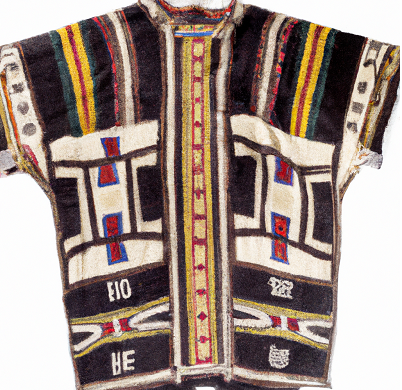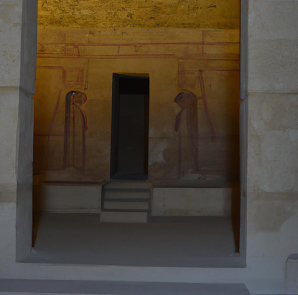In Medieval Burial Ground, a Rare Embroidered Deisis Epicting Jesus Christ Was Discovered
The Deisis is a type of religious art depicting the Virgin Mary, Jesus Christ and St. John the Baptist. It is often found in Eastern Orthodox, Roman Catholic, and other Christian churches. The term “Deisis” derives from the Greek word meaning “prayer” or “supplication”. The Deisis is a representation of the entreaty of the three persons of the Trinity for the salvation of humankind. It is an iconic depiction of Jesus Christ, the Virgin Mary and St. John the Baptist as supplicants entreating God for mercy and grace. The Deisis is an important part of the Eastern Orthodox artistic tradition and is often found painted or carved on the walls of churches and cathedrals. Recently, a rare embroidered Deisis depicting Jesus Christ was discovered in a Medieval burial ground. The embroidery was found on a piece of cloth that was buried with the deceased. The artwork depicts Jesus Christ with his arms outstretched in a gesture of supplication. He is flanked on either side by the Virgin Mary and St. John the Baptist. The embroidered Deisis is of particular interest to art historians and religious scholars.

The intricate detail of the embroidery suggests that it was created by a skilled artisan. The workmanship indicates that it was created in the late Middle Ages, between the 14th and 16th centuries. The symbolism of the Deisis was intended to convey the supplication of the three persons of the Trinity for the salvation of humanity. The Virgin Mary and St. John the Baptist are depicted as intercessors, asking God to grant grace and mercy to the deceased. The gesture of Jesus Christ is one of supplication and entreaty. The discovery of the embroidered Deisis in a Medieval burial ground is an important reminder of how religious faith and art were intertwined in the Middle Ages. The embroidery is a tangible reminder of how deeply the Christian faith was embedded in the life of the people at that time. It is a reminder of how the Christian faith was expressed in tangible ways and how it informed the lives of the people. The discovery of a rare embroidered Deisis depicting Jesus Christ in a Medieval burial ground is an important reminder of the past. It is a reminder of the importance that faith and art had in the lives of our ancestors. It is a reminder of the deep spiritual connection that was shared between the living and the dead in the Middle Ages.
Rare Inca Tunic Unearthed in Chile
Archaeologists in Chile have recently unearthed an incredibly rare Inca tunic, believed to date back over 500 years. The tunic was discovered in an ancient burial site located in the north of the country, near the city of Antofagasta. The burial site is believed to have been part of an Inca settlement, and the tunic is believed to have belonged to one of its inhabitants. The tunic is made of woven alpaca wool, which was commonly used in Inca clothing. It is decorated with colorful geometric patterns and features intricate embroidery. It is believed that the tunic was used for ceremonial or special occasions, and may have been worn by an important Inca person.

The tunic is an exceptional example of Inca craftsmanship and artistry. It is believed to date back to the 15th century, when the Inca Empire was at its height. The intricate detailing of the fabric and decorations shows the skill and artistry of the Inca people. The discovery of the tunic is not only an important archeological find, but also a reminder of the complex and advanced Inca culture that existed in South America. The Inca Empire was one of the largest and most powerful empires in world history, and its legacy can still be seen today in the art and architecture of the Andean region. The tunic is currently being preserved and studied by archaeologists, who are hoping to learn more about the Inca people and their culture. It is an incredible archaeological find that provides us with a unique glimpse into the past. The discovery of the tunic is a reminder of the skill and artistry of the Inca people, and the wealth and power of their ancient empire.
Archaeologists discover 1200-year-old Wari temple complex in Peru
Archaeologists have discovered a 1200-year-old temple complex in Peru, which is believed to be part of the Wari culture. This is an important discovery, as the Wari were a powerful pre-Incan society that flourished between AD 600 and 1000. The temple complex, located near the city of Ayacucho in central Peru, covers an area of over 4 hectares and contains several buildings. One of the most important structures is the Temple of the Sun, which is thought to have served as a religious centre. The temple is made up of three levels of terraces, with each level divided into two sections. The top two levels contain platforms for ceremonies and a sunken court for religious activities, while the bottom level holds a complex of small rooms and a tomb.

Archaeologists have also found a number of artifacts, including pottery and other objects that suggest the complex was used for both religious and administrative purposes. The discovery of the temple complex is significant, as it sheds light on the Wari culture and its influence on the region. It also gives us clues about how the Wari interacted with the other cultures that were present in the area at the time. The discovery of the temple complex is also important for understanding the development of the Wari culture and its eventual decline. As the site shows, the Wari were a powerful and influential group, but they were eventually superseded by the Inca. Overall, the discovery of the 1200-year-old Wari temple complex in Peru is an exciting find that provides insight into a previously unknown culture. It provides us with an invaluable record of the Wari’s history and culture, as well as hints at how they interacted with other cultures in the region.
Ancient Latin Texts Written on Papyrus Reveal New Information About The Roman World
The discovery of ancient Latin texts written on papyrus has provided a wealth of new information about the Roman world. Papyrus is an ancient type of paper made from reeds that were found in marshy areas of the Mediterranean. It was used by the ancient Romans to write texts, record legal documents, and create artwork. It is one of the oldest forms of writing material, and many of the texts that have been discovered on papyrus provide insight into the daily lives of the Roman people. One of the most exciting discoveries of ancient Latin texts written on papyrus is the discovery of the world’s oldest surviving written document. This document, known as the Tabula Habitan, dates back to the first century BC and was discovered in Egypt in the 19th century. It is a list of Roman citizens who lived in the area and includes their names, professions, and other information about them. This document provides a snapshot of life in the Roman Empire at the time and reveals how diverse the population was. Another important discovery of ancient Latin texts written on papyrus is the Papyri Graecae Magicae. This collection of text is comprised of over 500 ancient magical spells, rituals, and incantations, written in Greek and Latin. This collection provides insight into the various magical practices that were popular in the ancient Roman world and how they were used to control the supernatural.

In addition to these two discoveries, many other ancient Latin texts written on papyrus have been unearthed. These texts provide a wealth of information about the Roman world, such as religious practices, legal documents, and even recipes. By studying these texts, historians have been able to gain a better understanding of the lives of the Roman people and their culture. The discovery of ancient Latin texts written on papyrus has enabled historians to gain a much better understanding of the Roman world. This new information has shed light on the daily lives of the Roman people, their customs and beliefs, and their legal and political systems. In addition, it has also provided insights into the magical practices of the time. By examining these texts, historians have been able to gain a greater understanding of the Roman world and the people who lived there.
Excavators Say They’ve Found a Previously Unknown Egyptian Royal Tomb in Luxor
Excavators have made a remarkable discovery in Luxor, Egypt – a previously unknown royal tomb. The tomb is located in the Dra’ Abu el-Naga’ necropolis, which is known for having some of the most impressive tombs of the New Kingdom period, which lasted from the 16th to the 11th century BCE. The tomb is believed to have belonged to a royal family member, though the exact identity has not yet been determined. It dates back to the 18th dynasty of the New Kingdom period, and is thought to have been built in the reign of Pharaoh Amenhotep III. Inside, the tomb is decorated with brightly coloured wall paintings depicting scenes from the ancient Egyptian afterlife, as well as hieroglyphic inscriptions. In addition to the wall paintings, the tomb also contains several artifacts, including pottery, wooden furniture, and a limestone sarcophagus. The sarcophagus is inscribed with the name of the tomb’s owner, suggesting that the individual may have been a high-ranking member of the royal family.

The discovery of this tomb is significant not only because it is previously unknown, but also because it gives us a unique insight into the lives of the ancient Egyptians. It provides us with a window into their religious beliefs and funerary practices, as well as their use of art and architecture to commemorate their deceased. The tomb is now being studied by archaeologists and historians in order to learn more about its owner and the New Kingdom period. It is hoped that further discoveries will help us to better understand the lives of the ancient Egyptians and the customs that they practiced. In the meantime, the tomb will remain open to the public and will be open for guided tours. Visitors will be able to see the remarkable wall paintings and artifacts and get a glimpse into the lives of the ancient Egyptians.